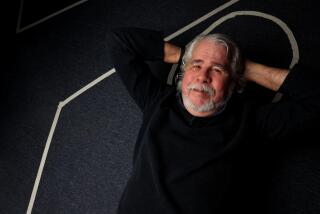A Dreary Donizetti in San Diego
SAN DIEGO — The San Diego Symphony, dedicated to the feckless art of the deceptive cadence, is teetering on the brink of Chapter 7 bankruptcy. The critic-at-large of the local newspaper blames an inept board of directors (“tourists too dazzled by the scenery to realize they’re being eaten by crocodiles”). Meanwhile, it’s business as usual for the San Diego Opera.
Saturday night at the Civic Theatre it turned out to be dreary business.
The vehicle was Donizetti’s “L’Elisir d’Amore,” a mellifluous comedy also, somewhat redundantly, looming on the agenda of the Music Center Opera in dark and distant Los Angeles. When this modest challenge was first (and last) attempted here, back in 1987, the San Diegans borrowed an antique bargain-basement production from San Francisco. Now Ian D. Campbell and Co. have borrowed a 3-year-old pretty-pretty production from Dallas that comes equipped with an antique motorcycle.
The wheels, it turns out, belong to Dr. Dulcamara, vendor of faux love-potions and other useful elixirs. Guided by the director John Cox and outfitted by the designer Roger Butlin, the buffo quack makes his entrance in the sidecar, leaving the driving to a trumpet-wielding sidekick.
It’s an amusing gimmick. But what does it have to do with an opera about pleasant peasants in early 19th century Italy? Not much.
According to the program, “L’Elisir”--which was written in 1832--takes place at the turn of this century. From the look of things, admittedly a rather contradictory look, the action actually unfolds a decade or two later than that, and the clime doesn’t seem particularly Mediterranean. Stephen Brimson-Lewis’ costumes flirt with 1920s fashions when they don’t resort to all-purpose rustic chic. Cox allows his militia to communicate via field phones. Butlin’s economical settings, basically bland window-dressing flats, were inspired by “the work of American artist Maxfield Parrish.”
The updating and transplanting, confused though they may be, do no serious harm. Donizetti has survived worse assaults. But the changes do no illuminating good either, and they certainly fail to reinforce the essential Italianate spirit.
Given a cast dominated by singers from Australia, New Zealand, England and America, it becomes doubly clear that we have traveled a far piece from the Teatro della Canobbiana. Was this trip necessary? Was getting here half the fun?
Well. . . .
The performance began with some predictably irrelevant pantomime during the overture. Adina, the fickle heroine, is now a schoolmarm who helps teach Italian to Italian children. Ask not why. We look forward, in any case, to the day when directors again trust the composer to set the scene alone, and trust the audience to sit quietly and listen.
Once the introductory silly business was over, the central silly business began. The jollity seemed a bit forced. Still, the push-button cheer wouldn’t have mattered much if the music-making had been inspired. No such luck.
Karen Keltner, maestra for all seasons, conducted with maximal vivacity and minimal expansion. She mustered much propulsion, little lyricism.
The lightweight ensemble offered one ray of vocal light: Deborah Reidel as Adina. The potential diva, who had made such a promising debut here two years ago in “La Sonnambula” (and was less happily cast in San Francisco as Donna Anna in “Don Giovanni”), sang with abiding purity, focus and sweetness, with unerring agility and astonishing freedom in the stratospheric passages bravely interpolated. Her shocking-yellow gown in the first act made her look for all the world like Big Bird lost during a migration far from Sesame Street. Nevertheless, Reidel acted sympathetically and, thank goodness, avoided laying on the saucy charm with a shovel.
Portraying little Nemorino, Patrick Powers tended to sing con belto when one most wanted bel canto), and often compounded the problem by pushing his lovely tenor sharp in the process. David Malis, sole holdover from the class of ‘87, brought splendid bravado to Sergeant Belcore’s mock-macho poses, but little weight to his florid convolutions.
Andrew Shore, a crisp-toned British basso making his American debut, played Dulcamara as a tweedy cross between Col. Blimp and Reginald Bunthorne. He was, in short, an amiable anachronism.
Sylvia Wen chirped very nicely as Gianetta, the supporting soubrette. Calvin Price blew the trumpet and manned the all-important motorcycle deftly. The chorus, trained by Dorothy Randall, sang lustily, as needed.
A good time was had by some.
* “L’Elisir d’Amore,” presented at the Civic Theatre, 202 C St., San Diego. Remaining performances Tuesday at 7 p.m., Friday at 8 p.m., Feb. 18 at 2 p.m. and Feb. 21 at 7 p.m. $23-$75. (619) 232-7636.
More to Read
The biggest entertainment stories
Get our big stories about Hollywood, film, television, music, arts, culture and more right in your inbox as soon as they publish.
You may occasionally receive promotional content from the Los Angeles Times.










